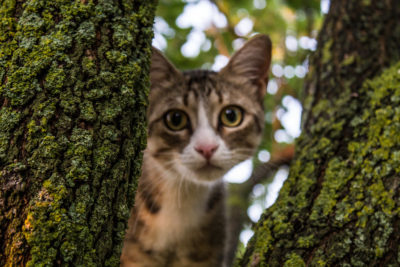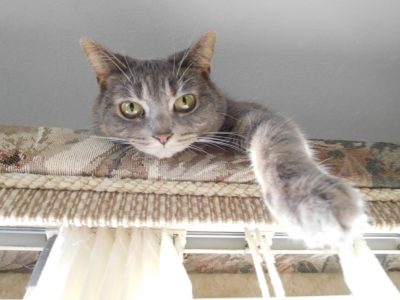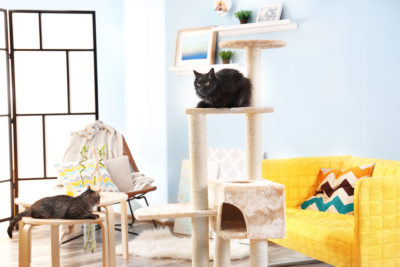You may wonder why your feline friend is usually seeking higher places to relax or watch. This behavior occurs due to mainly 5 reasons and most of them are part of the cat’s instincts. Let’s learn more about this interesting cat behavior.
1. Survival Instinctive Behavior
Domestic cats kept the survival instinctive behavior of their predecessors, the wild cats. In the wild when cats felt threatened they climb trees to be unreachable from predators. Staying up high was the ultimate way wild cats could survive from predators such as coyotes, foxes, wolves, owls, eagles or hawks. Trees provided not only the height cats needed to stay away from carnivores predators, but also the branches that acted as camouflage to hide from flying predators. Cats are highly secretive and vigilant and the main reason is their escaping and hunting instincts to survive.
Consequently, domestic cats carry the survival DNA information that makes them behave this way, feeling more confident being in higher spots. Following the same behavior, feral cats usually seek the safety of roofs to stay away from danger. Domestic cats also like to get up higher to be unreachable when they don’t want to be bothered. They just want to be left alone and relax this way, being away from high traffic. Also, they like to jump high to stay away from dogs at home.

2. Spotting preys
Cats have 200 degree angle of vision, wider than the 180 degree of humans. This wide angle of vision and the fact that cats like staying up high, increases the cat ability to perceive any movement on the ground. Higher hidden areas are the best natural spots for cats to hunt. The cat wide vision doesn’t allow them to see objects less than a foot from distance in front of them. However, when the cat is located in an elevated area, any movement can be easily detected. Staying in high places allows cats not only to spot a prey, but also to hide from potential predators at the same time.
Indoor cats love elevated porches or trees, especially close to a window so they can watch the outside observing the wildlife as if they are in the wild. They keep the hunting instinct that make them prefer to stay up high so they can spot anything below them.
3. Playing & exercising
A high place provides indoor cats the best area to play. Cats exercise their hunting skills by stalking, swatting or pouncing “preys” from higher spots. This “preys” could be you or another playmate cat. Don’t be surprised if your cat is sitting on a high spot and gives you a “boop” on your head as you walk by.
Cat trees or cat condos are excellent solution for this. They allow cats to climb and jump up higher, exercising their muscles and burning energy. If the cat tree features a scratching post, it provides an even closer similitude with a real tree, where the cat can scratch and leave its scent on it.

4. Elevation states territorial status in multi-cat households
For cats, being higher means better control over their territory. The more control, the more dominance over it. That’s why in multi-cat households it’s a good idea to keep separated areas with different elevations for each cat. This way they can coexist with a given hierarchy structure having each cat in its own spot. When cats have territorial confrontation one cat is usually the dominant and the other gets bullied the most. The dominant cat will always establish its dominance by staying in the higher spot, leaving the other cat in a lower position. This could mean a battle between cats trying to reach the same spot to state their territorial dominance. But eventually one cat will submit the rest.
By setting up shelves or porches on windows or walls you provide the indoor cats the means to coexist in a better way. Cat trees or cat condos also provide a structure where cats can hang up in the same area without territorial conflicts and where they can play as well.

5. Adaptation to temperature
Cats love sun bathing to warm up. They usually lay down on the floor, close to the windows where sunlight hits stretching their bodies with in a very relaxed position. Cats also stay warm by sitting in high areas where heat rises. This is especially true on winters when the heat systems at home create a warmer environment up higher. Cats are very versatile animals and they have learned how to adapt to the temperature at home to be comfortable.
Leave a Reply